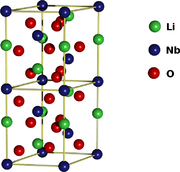Condensed matter physics
| Condensed matter physics |
 |
Phases · Phase transition
| Electronic phenomena |
| Quantum Hall effect · Spin Hall effect · Kondo effect |
| Quasiparticles |
Phonon · Exciton · Plasmon
Polariton · Polaron · Magnon
|
|
|
Condensed matter physics is the field of physics that deals with the macroscopic and microscopic physical properties of matter. In particular, it is concerned with the "condensed" phases that appear whenever the number of constituents in a system is extremely large and the interactions between the constituents are strong. The most familiar examples of condensed phases are solids and liquids, which arise from the electromagnetic forces between atoms. More exotic condensed phases include the superconducting phase exhibited by certain materials at low temperature, the ferromagnetic and antiferromagnetic phases of spins on atomic lattices, and the Bose-Einstein condensate found in certain ultracold atomic systems.
The aim of condensed matter physics is to understand the behavior of these phases by using well-established physical laws, in particular those of quantum mechanics, electromagnetism and statistical mechanics. The diversity of systems and phenomena available for study makes condensed matter physics by far the largest field of contemporary physics. By one estimate, one third of all United States physicists identify themselves as condensed matter physicists. The field has a large overlap with chemistry, materials science, and nanotechnology, and there are close connections with the related fields of atomic physics and biophysics. Theoretical condensed matter physics also shares many important concepts and techniques with theoretical particle and nuclear physics.
Historically, condensed matter physics grew out of solid-state physics, which is now considered one of its main subfields. The name of the field was apparently coined in 1967 by Philip Anderson and Volker Heine when they renamed their research group in the Cavendish Laboratory of the University of Cambridge from "Solid-State Theory" to "Theory of Condensed Matter". In 1978, the Division of Solid State Physics at the American Physical Society was renamed as the Division of Condensed Matter Physics.[1] One of the reasons for this change is that many of the concepts and techniques developed for studying solids can also be applied to fluid systems. For instance, the conduction electrons in an electrical conductor form a Fermi liquid, with similar properties to conventional liquids made up of atoms or molecules. Even the phenomenon of superconductivity, in which the quantum-mechanical properties of the electrons lead to collective behavior fundamentally different from that of a classical fluid, is closely related to the superfluid phase of liquid helium.
Topics in condensed matter physics
- Phases
- Interfaces
- Surface tension
- Domain growth - Nucleation; Spinodal decomposition
- Interfacial growth - Dendritic growth; Solidification fronts; Viscous fingering
- Crystalline solids
- Non-crystalline solids
- Soft condensed matter
- Nanotechnology
- Nanoelectromechanical Systems (NEMS)
- Magnetic Resonance Force Microscopy
- Heat Transport in Nanoscale Systems
- Spin Transport
See also
Notes
References
- P. M. Chaikin and T. C. Lubensky (2000). Principles of Condensed Matter Physics, Cambridge University Press; 1st edition, ISBN 0521794501
- Alexander Altland and Ben Simons (2006). Condensed Matter Field Theory, Cambridge University Press, ISBN 0521845084
- Michael P. Marder (2000). Condensed Matter Physics, Wiley-Interscience, ISBN 0471177792
